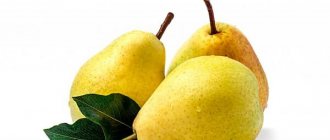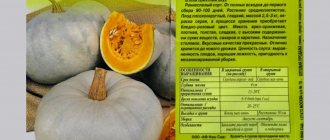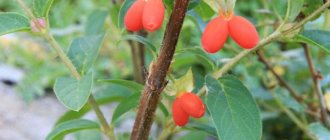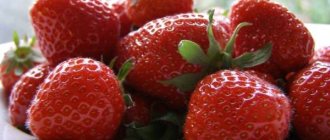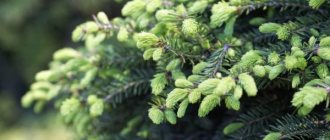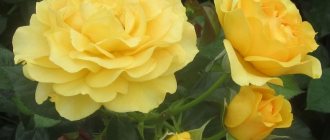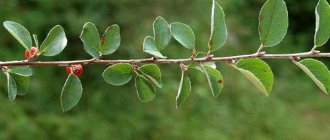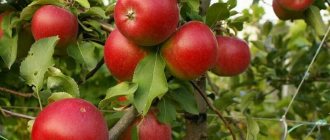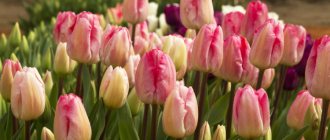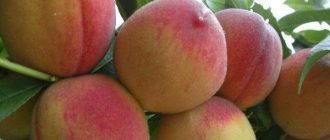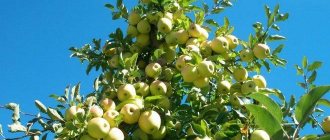Korean fir (Abies koreana) is an evergreen plant of the Pine family. In the natural environment, coniferous trees grow on the Korean Peninsula, in mixed and fir forests. The variety has been grown as an ornamental crop since 1907.
The evergreen beauty is a magnificent decoration of the local area, park area, city streets and squares
Full description of Korean fir
Korean fir is an amazingly beautiful tree. Many plant varieties have their own characteristics (color and size of needles, crown shape), but are characterized by common features:
- powerful, well-deep root system;
- spreading, cone-shaped crown;
- the bark is smooth, light gray, with thick brown-red cracks as the tree grows;
- shoots are yellowish, turning purple as they grow;
- apical buds are resinous, round;
- cylindrical cones;
- cones length up to 7 cm;
- diameter of cones up to 3 cm;
- the color of the cones is green, violet, purple as they ripen;
- lush, thick needles;
- the color of the needles ranges from silver, blue to rich, dark green;
- the needles are curved, flat, non-thorny, soft to the touch;
- needle length up to 15 mm;
- needle width up to 2.5 mm.
Cones are formed at the top of the tree crown, starting from 8-10 years of age, growing vertically upward. After ripening, they open and the seeds are released. A characteristic feature is the unique shade of the needles, which are colored on the lower part with a lighter tone or longitudinal stripes.
In sunlight, it seems that the needles on the Korean fir tree shimmer
Dimensions and height of an adult Korean fir
In the wild, Korean fir impresses with its size:
- the height of an adult tree is up to 15-20 m;
- trunk diameter up to 1 m;
- crown width up to 0.8 m.
Among modern decorative varieties there are dwarf (up to 40 cm in height) and medium-sized specimens (over 1 m in height).
Important! Fir trees are long-lived, some specimens reach 150 years of age
300-year-old Korean fir specimens are found in the wild
Growth rate
Korean fir grows very slowly in height - no more than 3-5 cm per year. The stem part, on the contrary, develops intensively. During the first 10-15 years of life, a coniferous tree grows at a slow pace. A 15-year-old Korean fir is considered mature and its growth rate increases to 30-50 cm per year.
To grow a beautiful ornamental plant on your site, you should be patient.
Where does Korean fir grow?
In its natural habitat, Korean fir grows next to birch, pine, and spruce. The plant's homeland is the southern regions of the Korean Peninsula, Jeju Island. The tree prefers rocky soil, at an altitude of up to 1850 m above sea level. A century ago, Korean fir was brought to the European part of the continent.
Due to its unpretentiousness to various climatic conditions, the evergreen tree grows throughout Europe.
Characteristics of Korean conifer
The tree comes from Korea and in the wild can grow up to 15 m in height. In its natural environment it is found in the northern hemisphere both in mixed forests and in mountainous areas. Korean fir has a wide crown. This happens due to the fact that the development of the trunk in width proceeds faster than its growth. There is another variety of the plant - a dwarf one, with an attractive spherical crown.
Evergreen garden decoration
The branches of the conifer are densely covered with bright green needles, which do not change their color throughout the year. From below, each needle has a silvery coating and veining. Young trees have hard needles, while older trees have dull needles. They can reach 2 cm in length and 2.5 mm in width. The shoots are covered with light gray bark, which becomes reddish with age. The fruits of the Korean beauty are purple cones, their length can reach 8 cm. They are formed in the upper parts of the tree on young shoots. After reading the description and looking at the photos, it’s hard to deny yourself such exotica. If desired, you can purchase cross-pair microbiota as an addition to the composition.
Features of the species:
- The average lifespan is 150-200 years, but there have been specimens 4 hundred years old.
- Does not tolerate prolonged drought well, but boasts frost resistance.
- It takes root in slightly acidic and alkaline soils.
Placement among the stones
- If not properly cared for, the fir becomes like a shrub and its growth slows down significantly.
- The phytoncides released by the tree disinfect the air and repel pests.
- It does not tolerate urban polluted air well, so it is not recommended to plant it near the roadway.
Varieties of Korean fir
Today, a large number of decorative varieties of Korean fir are known. Many artificially bred varieties deserve special attention. When designing an area, landscape designers around the world successfully use the best specimens. The main types and varieties of Korean fir presented in the photo will help create a general impression of a beautiful evergreen plant.
Korean Fir Molly
Description of Korean fir Molly:
- crown cone-shaped;
- crown height up to 7 m;
- crown width up to 3m;
- cones of a dark purple hue;
- cones length up to 5 cm;
- needles are flat, densely located;
- the color of the needles on the upper part of the crown is bright light green;
- the color of the needles on the lower branches is silver-white, light blue;
- tree growth rate is up to 6-7 cm per year.
Important! The Molly variety is a light-loving crop that does not grow well in the shade and prefers well-moistened soils with good drainage. The plant is sensitive to sudden temperature changes.
The Molly variety does not require crown formation
Korean fir Diamond
Evergreen Korean fir Diamond is a magnificent decorative dwarf variety that is distinguished by a rich coniferous aroma and the following characteristics:
- the root system is compact, well developed;
- crown height up to 60 cm;
- crown diameter up to 80 cm;
- the bark is smooth, gray, without folds or grooves;
- the crown shape is flattened, spherical or hemispherical (in rare cases, pyramidal or cone-shaped);
- growth rate up to 4 cm per year;
- needles curved at the edges, soft, short, densely and tightly planted;
- needles length up to 2 cm;
- the color of the upper part of the needles is from light green to dark green;
- the color of the lower part of the needles is silver;
- cones are vertically located, candle-shaped;
- the color of the cones on a young plant is from purple to blue-green;
- The color of the cones on an adult plant is dark brown.
The Brilliant variety is ideal for growing in tubs, flowerpots, and pots due to the compact size of the root system. The dwarf decorative variety prefers light or slightly shaded, windless areas. The soil for growing coniferous plants is slightly acidic and well-drained. The decorative crop tolerates frosts well down to -29 ⁰C.
Attention! The lifespan of the dwarf Korean fir Brilliant is 300-400 years.
For the first few years, Korean fir seedlings of the Brilliant variety are best grown in a greenhouse.
Korean fir Silberlocke
The description of the Korean fir Silberlocke (Silberlock) includes a beautiful evergreen tree bred by German breeders in the late 80s of the last century. This variety does not have resin channels, and the enzyme is formed on the surface of the branches. The plant is characterized by the following characteristics:
- crown height up to 2-5 m;
- the crown is perfectly symmetrical, pyramidal, lush;
- the trunk is thick at the base, gradually widening towards the apex;
- the direction of branch growth is upward;
- The color of the bark of young trees is gray;
- The bark color of mature trees is dark brown with characteristic cracks;
- growth rate up to 12 cm per year;
- the color of the upper part of the needles is dark green;
- the color of the lower part of the needles is light green;
- the shape of the needles is twisted;
- aroma of lemon needles;
- cones length up to 6 cm;
- diameter of cones up to 3 cm;
- The color of the buds is purple.
Cones form only on seven-year-old trees. The Silberlok variety is characterized by high frost resistance, heat resistance and drought resistance.
Important! Neutral, slightly acidic, saline, alkaline, and loamy soils are suitable for the crop. The plant reacts painfully to being in the shade and excessively moist soil with poor drainage.
The lifespan of the Korean Silberlock fir is about 50 years.
Korean fir Cohouts Ice Breaker
The Kohout's Icebreaker variety is the most extravagant representative of the Pine family. The famous German scientist Jörg Kohoutem developed this variety, which is why the plant bears his name. The literal translation of the name of the Korean fir variety Icebreaker sounds like “Icebreaker of Kohout”. The external outline of a mature Cohout's Icebreaker tree resembles a small ball strewn with ice fragments. The following features are characteristic of evergreen crops:
- tree height up to 50-80cm;
- tree crown diameter 1.2 m;
- trunk diameter 5 cm;
- shoots are short, densely located;
- the bark of young trees is light brown;
- the bark of mature trees is dark brown with a gray tint;
- the needles are sickle-shaped, curved upward, short, soft to the touch, with blunt tips;
- the underside of the needles is white;
- the upper side of the needles is silver-blue;
- needles length up to 2 cm;
- Czech cylinder cones, candle-shaped, directed upward;
- cones length up to 6 cm;
- diameter of cones up to 3 cm.
Attention! The growth rate of the Kohouts Icebreaker variety is small; ten-year-old trees grow no more than 30 cm in height.
The dwarf variety Kohouts Icebreaker is characterized by a high degree of winter hardiness
Korean fir Blue Magic
Korean fir Blue Magic is one of the new popular varieties, bred from Blauer Pfiff seeds. The ornamental plant has the following properties:
- tree height up to 2 m;
- crown diameter from 1.5 m to 2 m;
- the shape of the crown is cushion-shaped, in some cases in the form of a cone;
- the color of the needles on a tree planted in a sunny area is silver-blue;
- the color of the needles on a tree planted in the shade is blue-green.
The decorative variety Blue Magic tolerates frosty winters well and prefers well-drained, moderately moist fertile soil (slightly or moderately acidic).
Dwarf Blue Magic is ideal for decorating gardens, alpine slides, in group plantings and as a tapeworm
Korean fir Tundra
The dwarf variety Tundra is an unpretentious, frost- and winter-hardy plant, which is characterized by the following properties:
- cushion-shaped crown;
- crown height up to 40 cm;
- crown diameter up to 60 cm;
- bark color reddish brown;
- the needles are short, soft, glossy;
- the color of the needles on the upper side is bright green;
- the color of the needles on the underside is silver;
- cylindrical cones with large resin drops;
- the color of the cones is purple, violet;
- The length of the cones is up to 7 cm.
The Tundra variety is winter-hardy and unpretentious. The plant is sensitive to insufficient moisture and does not grow well in sandy soils.
The growth rate of the Tundra variety is very slow; at the age of ten, the tree reaches a length of about 30 cm. In winter, the color of the Tundra variety's needles changes color.
Miniature Korean Tundra fir does not need pruning and looks impressive in containers, boxes and other containers
Korean fir Compacta
Korean fir of the Compacta variety is a beautiful evergreen plant, which is characterized by the following characteristics:
- tree height from 0.8 m to 2 m;
- crown diameter from 1.5 m to 3 m;
- the needles are soft, short;
- the color of the upper part of the needles is dark green;
- the color of the lower part of the needles is silver-blue;
- the color of young shoots is bright green;
- cones length up to 15 cm;
- The color of the buds changes from green, to purple, and then to brown.
The Kompakta variety is winter-hardy and frost-resistant.
Important! For Korean Compact fir, it is necessary to choose well-drained areas, slightly shaded areas, since the ornamental crop does not tolerate sunburn.
The Kompakta variety grows very slowly, the average growth per year is about 7 cm
Korean fir Bonsai Blue
The Bonsai Blue variety is a unique representative of the Pine family. During the first years of life, the dwarf tree only grows in width, forming an asymmetrical surface. After eight years, an apical shoot appears, and by the age of ten the plant reaches 50 centimeters in height. The diameter of the crown is about one meter. The evergreen Bonsai Blue is characterized by the following features:
- the height of an adult tree is up to 3 m;
- the needles are soft, flat in shape;
- The color of the needles is blue-green.
Important! The Bonsai Blue variety prefers well-lit places, partial shade, and tolerates frosts down to -29 ⁰C without shelter.
The annual growth of the Bonsai Blue crown is about 5 cm
Korean fir Oberon
The dwarf hybrid variety Oberon bears the following characteristics:
- cone-shaped crown;
- tree height up to 40 cm;
- crown diameter up to 60 cm;
- the color of the needles is glossy, bright green;
- the needles are short, small, with curled edges;
- vertically arranged cones with dense, resinous scales.
Well-moistened, nutritious soil is suitable for the Korean frost-resistant Oberon fir variety. At first, the plant will be most comfortable in light partial shade.
The growth of the dwarf fir tree Oberon is about 7 cm per year
Korean fir Silver
Variety Silver (Silver) - Korean fir with blue cones. A short representative of the Pine family is distinguished by the following characteristics:
- crown shape conical, dense;
- the height of an adult tree is up to 6 m;
- diameter of the lower part of the crown up to 1.5 m;
- needles are short;
- needles length up to 2 cm;
- the color of the needles on the upper side is blue-green;
- the color of the needles on the underside is silver;
- cones numerous, cylindrical in shape;
- cones length up to 7 cm;
- The color of the buds changes from green to purple and then red.
Important! During periods of drought, the plant must be sprayed with warm water in the morning and evening hours.
Korean variety Silver should be planted in well-lit areas
Silver Show
The Silver Show variety is an artificially bred ornamental plant from the mother variety Silberlock. Translated from English, the name sounds like “silver show”. An evergreen tree has the following properties:
- crown of regular shape, narrow-conical, dense;
- the height of an adult tree is from 5 m to 10 m;
- crown width from 1.5 m to 4 m;
- needles twisted, curly;
- the color of the needles from the bottom is silver;
- cones numerous, erect;
- The color of the buds is purple.
The annual growth of the Korean Silver Show fir variety averages up to 15 cm per year.
Cool climates are ideal for Silver Show. The plant does not tolerate windy places and dry summers. The variety is suitable for nutritious, light, loamy soil, moderate watering, sprinkling of the crown, fertilization with copper-containing compounds. Silver Show should be planted in sunny areas of the garden or in light partial shade.
On sunny days, the twisted needles shimmer, and it seems that there are white snowflakes lying on the branches of Silver Show
Silver Star
The Silver Star variety is a spectacular representative of the Pine family. The ornamental plant is endowed with the following characteristics:
- crown of irregular cone shape;
- tree height up to 1 m;
- crown diameter up to 0.8 m;
- the color of the upper part of the needles is bright green;
- the color of the lower part of the needles is silver or white.
For seedlings of the Silver Star variety, you need to choose sunny or slightly shaded areas of the garden. The plant prefers loamy, soddy-podzolic, sandy loam soils.
The annual growth of the Silver Star tree is about 10 cm
Blue Emperor
The Korean fir variety Blue Emperor is a dwarf variety with characteristic features:
- the crown is cushion-shaped, creeping, irregular in shape;
- tree height up to 1.5 m;
- crown width up to 1.5 m;
- the bark of young plants is smooth, light gray;
- the bark of adult plants is red-brown with characteristic grooves;
- the needles are short, slightly rounded at the ends, soft to the touch;
- the color of the upper part of the needles is silver-blue;
- the color of the lower part of the needles is marked with two wide white stripes;
- buds are grooved, yellow, then purple;
- young shoots are light green;
- cones of an elongated shape, vertically located, with bent scales;
- cones length up to 7 cm;
- The color of the buds is blue, purple or violet.
Korean blue fir Blue Emperor is a unique plant whose needles are shaped like small leaves.
For dwarf Blue Emperor, areas in partial shade or full sun are suitable. Evergreen tree seedlings should be planted in nutritious, well-drained soil. The variety does not tolerate stagnant moisture or drought.
The Blue Emperor variety is not characterized by the presence of one distinct trunk (central shoot)
Green Carpet
The Korean variety of evergreen fir Green Carpet is a unique plant that was bred through selection in the Netherlands in 1985. Translated into Russian, the name sounds like “green carpet”. A beautiful creeping variety with characteristic properties:
- the root system is superficial;
- cushion-shaped crown;
- tree height up to 50 cm;
- crown width up to 1.5 m;
- shoots are hard, short;
- the needles are short, with a glossy surface;
- the color of the upper surface of the needles is green;
- the color of the lower surface of the needles is whitish;
- The color of the buds is first green, purple, then brown.
The Green Carpet variety develops best in sunny areas or partial shade. Fertile, acidic, slightly alkaline, well-drained soil is suitable for Green Carpet seedlings.
The annual growth of the Green Carpet variety is up to 7 cm per year
Select
The Korean evergreen fir variety Select is an exquisite, slow-growing plant. The following characteristics are characteristic of decorative culture:
- crown is symmetrical, wide-conical;
- tree height up to 4 m;
- the needles are soft, slightly curly, short, glossy;
- the color of the upper part of the needles is dark green;
- the color of the lower part of the needles is white;
- cones length up to 4 cm;
- purple cones.
The dwarf variety Select grows best in fertile, well-lit soils. Select seedlings can be planted on sandy, loamy, fertile, well-drained soils.
The Korean fir variety Select is considered frost-resistant
Taiga
The Korean decorative fir variety Taiga is an exquisite ornamental crop characterized by the following properties:
- crown hemispherical, creeping;
- tree height up to 0.8 m;
- crown diameter up to 0.6 m;
- needles are short;
- the color of the upper part of the needles is dark green;
- the color of the lower part of the needles is gray.
Korean dwarf fir Taiga prefers sunny areas or partial shade. Fertile soil with good drainage and moderate watering are suitable for the plant.
The miniature Taiga fir reaches a height of up to 30 cm by the age of ten, with a crown diameter of up to 60 cm
Dwarf varieties of Korean fir
The dwarf varieties of Korean fir in the photo and in the description are ornamental plants, the height of the bushes reaching 60-80 cm.
The following varieties are considered the most popular and in demand by landscape designers:
- Diamond, the crown height of which reaches up to 60 cm;
- Ice Breaker (Kohout's Icebreaker), crown height up to 80 cm;
- Tundra, crown height up to 40 cm;
- Oberon, crown height up to 40 cm;
- Green Carpet, crown height up to 50 cm;
- Taiga, crown height up to 80 cm.
Korean fir in a pot is an ideal solution for decorating balconies, verandas, local areas and small architectural forms.
Despite their large size, quite a lot of cones are always formed on dwarf trees
Varieties of Korean fir for the Moscow region
According to the photo and description of the Korean fir variety, the following varieties are ideal for growing in the climatic conditions of Central Russia and the Moscow region:
- Diamond;
- Tundra;
- Oberon;
- Bonsai Blue.
Most of the listed varieties belong to the fourth climatic zone. Ornamental varieties are ideally suited for growing in the middle zone. Plants of this group belong to winter- and frost-resistant crops and can withstand temperatures down to -29 ⁰C.
Some winter-hardy varieties of Korean evergreen fir, suitable for growing in the Moscow region, require winter shelter
Korean fir in landscape design
The many faces of Korean fir are widely used to decorate local areas. Trees combine perfectly with other plants, ornamental shrubs, perennial and annual flowers, and herbs.
Well, Korean evergreen fir coexists with thuja, spruce, pine, larch, and maple. Decorative crops are used for various purposes:
- as a green hedge;
- as a component of a rock garden or alpine hill;
- to design a recreation area.
Medium-sized or dwarf Korean fir is a unique plant for decorating any stylistic direction of landscape design
Fir in landscape design
Coniferous plantings will become a real decoration of any site. They are used in flower beds, alpine slides, stone gardens and rockeries. Different shades of pine needles combine well with each other, highlighting each other favorably.
With the help of group plantings, you can zone open areas, organize hedges near gazebos and recreation areas. In combination with deciduous plantings, fir trees create beautiful compositions.
Knowing the rules of pruning, coniferous plantings can be given any shape; such a tree will become an object of attention and admiration.
Dwarf varieties go well with deciduous shrubs, thujas, and flowers.
Korean fir is distinguished by its longevity. And it depends only on proper planting and care whether it will become a chic decoration of the site or turn into an unsightly tree occupying a large area.
How to propagate Korean fir
Fir, like any coniferous plant, can be propagated in two main ways:
- seminal;
- vegetative.
The seed propagation method is suitable for breeding new varieties. Vegetative means cuttings and division by layering.
Propagation of Korean fir by cuttings
Korean varieties of evergreen fir are successfully propagated by cuttings. Planting material is harvested from four or eight year old plants. The optimal size of cuttings is 10-25 cm. On a branch that is to be cut to form cuttings, one viable bud is sufficient. Planting fir in the Korean spring is the most acceptable time for vegetative propagation. Stages of work:
- preparation of cuttings;
- ensuring correct storage conditions in a special substrate;
- rooting cuttings;
- moving seedlings open ground.
Annual shoots without visible damage are used as cuttings.
How to grow Korean fir from seeds
Seed material can be prepared from ripened cones of evergreen Korean fir. Growing ornamental plant seedlings from seeds is done in stages:
- the seeds are taken out from the cones and dried;
- in March, seed material begins to germinate;
- disinfection of seeds in a solution of potassium permanganate;
- washing and soaking the seeds for a day until they are completely swollen;
- placing seeds in a humid environment (wet sand);
- stratification of seeds in the refrigerator for one month;
- planting seeds in a container for germination in April;
- seedling care (fertilizer, watering, loosening);
- moving four-year-old seedlings into open ground.
Four-year-old seedlings planted in the ground in the fall take root best
By layering
Reproduction of an ornamental crop by layering allows one to completely preserve varietal characteristics. In spring, the branches are bent to the ground, dug in, and the tops are raised. The bending points of the branches are fixed with a weight. The survival time of cuttings is from one to two years. After final rooting, the mother branch is separated from the young seedling.
During the rooting period, cuttings require intensive watering
Advice from experienced gardeners on growing Korean fir
Useful tips to avoid common problems:
- needles are sensitive to bright light, in hot weather it is important to spray with cold water, cover young plants with a protective screen;
- fir does not tolerate waterlogging, which can lead to fungal infections of the root system; during planting it is important to ensure good drainage;
- treatment against diseases and pests is carried out twice a year - in spring and autumn, this provides reliable protection throughout the season;
- You can take annual seedlings for planting, but it is better to prefer plants that are 3–5 years old - they adapt faster and are less likely to die in a new place;
- pruning to create a decorative form is required only from the 3rd year of life, the optimal time for work is the first half of April.
Resin can be collected from mature plants. It has antiseptic properties and is suitable for creating home remedies. An infusion of fir needles can be used in bath procedures to aromatize steam.
Korean fir is an ornamental plant actively used for landscaping. There are many varieties that differ in appearance and resistance. The choice should be made taking into account the entire landscape composition on your site.
Caring for Korean fir at home
Caring for Korean decorative fir requires compliance with the basic requirements of agricultural technology:
- timely and sufficient watering;
- optimal feeding;
- pruning and haircut;
- preparation for winter;
- control of diseases and pests.
At home you can grow magnificent specimens of evergreen Korean fir
Care
Korean fir is demanding only at a young age. The first 3-5 years should be provided with sufficient care, including:
- watering;
- loosening;
- weeding;
- fertilization;
- pruning;
- protection of young seedlings from adverse environmental influences;
- prevention of diseases and pests.
It is recommended to loosen the tree trunk circle as needed. It is enough to capture 5 cm of the surface. Remove weeds in a timely manner. They take nutrients from the roots located above, create a threat of infection of the fir, and are home to many pests. Mulching with fallen pine needles will help reduce the frequency of these procedures.
Violation of the watering regime causes a decrease in immunity.
Compliance with agricultural practices protects the crop from the development of diseases. Violation of the watering regime, lack of light and air are the causes of decreased immunity. Often in this case, Korean fir is affected by rot. Dangerous pests include hermes, spider mites, and various bugs. Plants should be inspected regularly and treated with insecticides in a timely manner.
Watering
The procedure is needed only for young plants that have not had time to take root well. The exception is decorative hybrids, which are more demanding in terms of growing conditions. Korean fir prefers moist soil, without stagnant water. During the rainy season, cancel the procedure; in case of drought, water generously once every 6-8 days. The culture responds gratefully to moistening by sprinkling. It is important not to do this during the day so that the needles do not get burned under the influence of the sun.
Top dressing
The first time is carried out 3 years after planting. One spring application of fertilizer during watering is sufficient per year. You can use a complex universal additive for coniferous species. From organic matter, it is permissible to water with a weak solution of humus or bird droppings, infused for several days. It is important to water abundantly after fertilizing so as not to burn the root system.
Trimming
The crown of the Korean variety of fir forms independently. Only sanitary pruning is required to remove diseased, dried out and pest-infested branches. In autumn, it is recommended to remove the central buds on the side shoots. Some varieties do not tolerate pruning very well and may react with the appearance of dried branches. The crop grows slowly, so it will take a long time to overgrow a remote area.
Preparing for winter
Korean fir is covered with spruce branches or non-woven material for the winter.
The characteristics of many varieties of Korean fir indicate the winter hardiness of the crop. Some varieties tolerate even severe frosts well, but this only applies to adult plants. Young seedlings should be additionally covered. Mulch the tree trunk circle with pine litter, peat or sawdust. Cover the tree itself with spruce branches or non-woven material. It is not advisable to use foam, since fir requires air. The shelter also protects against burnout of needles and the formation of frost holes on the trunk.
Planting and caring for Korean fir
Choosing the right place for a plant, following the basic deadlines and planting algorithm is the key to a healthy and beautiful tree. Subsequent care and cultivation of Korean fir in compliance with all rules of agricultural technology allows you to obtain magnificent specimens on the site.
Deadlines
Agricultural technology for growing Korean evergreen fir requires compliance with planting deadlines. The ornamental plant can be planted in open ground in spring or summer. Such specimens require proper watering, and if certain agricultural standards are not followed, they most often die.
The best time to move seedlings into open ground is early autumn. Before the onset of winter, the planting material will gradually take root, and low autumn temperatures and increased humidity levels during this period of the year will contribute to deeper establishment.
Compliance with the correct timing of transplanting fir to the site will increase the exquisite collection of conifers in the garden
Site selection and soil preparation
Many people consider the Korean evergreen fir to be an unpretentious representative of the Pine family. A detailed study can reveal some “preferences” of an ornamental plant for a planting site:
- moist soil without stagnant water;
- good drainage system;
- loamy soil;
- sufficient amount of fertilizer.
Most varieties of decorative Korean fir prefer well-lit or slightly shaded areas
Landing algorithm
Two weeks before planting, the hole should be prepared. Its dimensions are 60x60x60 cm. 2-3 buckets of water are poured into the prepared hole until completely absorbed. The bottom is dug up, filled with crushed stone or broken brick, 5-6 cm thick. The hole is half filled with a fertile mixture of the following ingredients:
- part of the peat;
- part of the sand;
- two parts clay;
- three parts of humus;
- 10 kg of sawdust;
- 200-300 g of nitrophoska.
After two weeks, after the soil mixture has settled in the planting hole, a seedling is placed in the center of the hole, the roots are straightened and the hole is filled to the top with prepared nutrient soil.
The planting site is watered abundantly. To grow a decorative fir alley, you should maintain a distance between planting holes of 4-5 m.
The planting pattern between seedlings for loose groups is 3-3.5 m, for dense groups - 2.5 m.
Growing Korean fir
Compared to other coniferous crops, Korean ornamental fir easily adapts after moving to open ground. After final rooting, young seedlings require proper care.
Watering and fertilizing schedule
Fir is watered in case of dry summer. Moisture-loving varieties need irrigation 2-3 times during the summer season. Other species do not tolerate waterlogging; natural precipitation is sufficient for them.
Fir is fertilized 2-3 years after planting. Complex fertilizers for conifers are applied to the tree trunks of mature trees in the spring.
For one Korean decorative fir tree, 15-20 liters of water per watering is enough
Loosening and mulching
Loosening the soil around the near-trunk space of the Korean evergreen fir is indicated after each watering. This should be done to a depth of 10-15 cm. During the procedure, weeds must be completely removed.
Mulching is necessary for young seedlings. To do this, use wood chips, peat, sawdust in a layer of up to 8-10 cm.
The mulch should be located close to the root collar of the tree
Rules for cutting Korean fir
Trimming is necessary for some varieties of Korean decorative fir. Pruning is done in the spring before sap flow begins. Using garden shears, remove dry, damaged branches and, if necessary, form a crown. Spring annual pruning involves removing no more than 1/3 of the length of the branches.
In most varieties of evergreen Korean fir, the crown does not require formation
Trimming the top of a Korean fir
Experts and experienced gardeners recommend never cutting off the tops of Korean decorative fir. Such manipulations can lead to the death of the plant. This is explained by the fact that when cutting the top, the natural balance between the root system and green mass is disrupted.
Preparing Korean fir for winter
Most varieties of Korean decorative fir can withstand air temperatures down to -39 ⁰C. For winter shelter of young seedlings, you can use spruce branches, which completely cover the rhizome and crown.
Only young specimens need protection during the winter cold.
Features of planting Korean fir
Having decided to grow this amazing tree near your home, you should not forget about the many nuances associated with its origin. Planting and caring for Korean fir largely depends on compliance with the conditions in which it grows in its homeland.
Choosing a planting site and soil requirements
Korean fir naturally lives in the subtropical and temperate zones. When choosing a planting site for it, you must remember that the plant loves a lot of light. Almost all varieties develop well in open sunny space, only some tolerate light partial shade. Due to lack of lighting, the crown loses its attractiveness, the branches stretch out and lose their compact shape. The color of the needles can also change shade and differ from that stated when purchasing the variety.
The plant, especially young seedlings, do not like strong winds and do not tolerate drafts well. When choosing a planting site, you should also take into account the proximity of neighbors, which in the future may affect the symmetrical development of the crown. One more nuance should not be forgotten - the root system of Korean fir is not located too deep in the soil.
The tree does not make serious demands on the composition of the soil and grows even on heavy clay soils. However, it is still better to plant it on sandy, slightly acidified soils containing sufficient organic matter. The main thing is that the plant does not end up in a hollow where water collects after rain or melting snow.
Planting Korean fir correctly
The best time for planting is early spring, when young needles have not yet appeared. Seedlings that are at least 4 years old, but not more than 10 years old, should be planted in open ground in a permanent place of growth. Plants younger than these years practically do not take root - in the summer they die from the heat, in the winter from frost, neither watering nor careful covering helps.
The size of the planting hole directly depends on the size of the root ball, but its depth, as a rule, does not exceed 85 cm and should not be less than 50 cm. Peat, humus, a little humus and mineral fertilizers are added to the selected soil, everything is thoroughly mixed and poured onto the bottom mound.
A seedling is placed on top of it, the roots are thoroughly straightened and the remaining soil mixture is poured into the hole. The root collar should remain at ground level, not deeper. Everything is compacted well and watered with enough water - at least 2-3 buckets.
The distance from the soliter tree to neighboring plantings is maintained at approximately 6 m. If fir trees are planted in a row to create a beautiful hedge, then it is allowed to leave 2-3 m between them.
Diseases and pests of Korean fir
Improper care can provoke the manifestation of pathogens of fungal and bacterial diseases:
- Rust is a dangerous fungal disease. Orange bubbles on the needles are signs of spores. The green mass dries out and dies over time, and the plant gradually dies.
To combat rust, the crown and wood are treated with modern fungicides (Skor, Raek)
- Schutte brown is a fungal disease caused by the fungus Herpotrichia guniperi. Most often, spores begin to develop under snow cover. In spring, schutte appears on the needles as a thick, black or brown coating.
Preparations Profit, Acrobat, Ordan will help you get rid of brown chute on decorative Korean fir.
- Bacterial dropsy occurs as a result of infection by bacteria of the genus Erwinia. Pathogenic microflora changes the color of the needles. The needles turn yellow, become brown, and then gray. The plant gradually fades and dries out.
There are no ways to combat bacterial dropsy yet, so affected specimens should be removed from the garden bed
- Rot affects fir as a result of exposure to various types of fungi. Most often, ornamental varieties suffer from variegated, white fibrous, and white sapwood rot. Pathogenic microflora infects the root system, trunk, tree branches, needles and cones.
Spraying with fungicides will help prevent the spread of pathogenic fungi (Champion, Fundazol)
Among the pests, the following pose a particular danger to Korean decorative fir:
- Spider mites are the most common pests. Their presence can be seen by the white thin web. Yellow spots appear on the needles, and the needles fall off.
Complex acaricidal preparations (Caesar, Nurel-D) will help rid fir of spider mites.
- Scale insects harm coniferous plants. The needles on which the pest settles fade and fall off. Trees lose their decorative appeal.
To combat scale insects, the drug Aktara is used
- Leaf rollers damage young fir shoots. Destroyed growth points and spider nests appear on affected plants.
Caterpillars of leaf roller butterflies can be destroyed with chemicals Karbofos, Fufanon
Kinds
Further in the article we will talk about the varieties of Korean fir. Choosing the right variety is quite a difficult task. We will have to carry out some selection work. Currently, you can purchase almost any seeds of this plant. To do this, you need to contact one of the agricultural companies. It is recommended that you familiarize yourself with the features of each type before making your final decision. You should not waste time growing a variety that does not fit into the landscape of the site or that its owner does not like.
Decorative variety 1
Korean Molly fir is closest in biological characteristics to the original species plant. A tree of this variety grows up to 5 m. The width of the crown in the lower part is up to 4 meters. The plant is distinguished by a pleasant to look at, delicate green color. The bottom surfaces of coniferous blades are cast in blue and silver shades. Despite its rather slow growth (maximum 7 cm per year), this variety is very popular among landscape designers. However, the plant attracts many due to the early formation of an attractive spreading crown.
Decorative variety 2
Korean fir Silberlok is a cultivated variety. Its main advantages include active growth and exquisite silver needles. Now this variety is quite popular. To grow it, it is necessary to adhere to agricultural technology and use special fertilizers. If everything is done correctly, the shoots will add 11-12 cm in height every year.
Decorative grade 3
Korean fir Blue Emperor is an asymmetrical or cushion-shaped dwarf shrub. The plant is characterized by slow growth and high decorative value. Young plants initially have a bushy form. Over time it becomes tree-like. This variety of fir has short, silver-purple needles. The lower part of the needles is white. Thanks to the unusual color of the needles, the tree appears bluish-blue. It is preferable to plant the variety in the sun or in semi-shaded areas with a moderate warm climate. The plant has high winter hardiness. But at the same time, strong winds can damage the needles. In this regard, it is recommended to protect the plant for the winter.
Pruning and covering fir for the winter
Firs really don’t like being disturbed by transplanting and pruning. However, sanitary pruning can be carried out in the spring before sap flow begins. During this pruning, carefully remove damaged and dead branches using garden shears. Fir has a beautiful and compact crown, which practically does not require its formation, especially in the first 10 years. However, if there is an urgent need in the spring, you can cut the shoots by no more than a third.
Most of the fir varieties grown on our territory are winter-hardy, but it is better to cover young plants with spruce branches for the winter. In this case, the tree trunk circle should be sprinkled with a layer of peat.
Types of fir
Siberian fir
The only type of fir that naturally grows in the North-West, and even then only in the east of the Vologda and Arkhangelsk regions. The main part of its range, as can be seen even from the name, is located in Siberia (Western and partly Eastern), in the Sayan Mountains, Altai and the Urals. This is the most common among all Russian firs. Siberian fir is a tree up to 30 m tall and 55 cm in diameter. The bark is smooth, dark gray. Under it there are numerous nodules filled with aromatic balm.
Its crown is narrow pyramidal. Living branches come from the very base of the trunk. Its needles are flat, narrow-linear with a rounded tip, up to 30 mm long, soft, dark green, shiny. They remain on the tree for 7–10 years. This fir begins to bear fruit at the age of 20 (in the wild). The cones are oval-cylindrical, sit at the ends of the branches, light brown, resinous, up to 9 cm long and 4 cm wide, they ripen in August–September. The weight of 1000 seeds is 10.5 g, the germination rate of even fresh seeds is quite low - about 50%, after a year it drops to 30%. At 10 years old, young trees reach a height of two meters, and at 20 - 5.5 m.
Siberian fir satisfactorily tolerates excess flow moisture. Loves relatively rich loamy soils. Can grow on limestone. It is very frost- and winter-hardy, but suffers from spring return frosts, however, without serious consequences. Lives up to 300 years. Mature trees are often affected by heart rot. She has the following decorative garden forms: Araucarioides, Candelabrum, Columnaris, Pendula; dwarf - Monstrosa, Nana; variegated - Variegata, Glauca, Viridis, as well as long-coniferous - Longifolia.
Fir whole leaf, Manchurian, black
It grows naturally in the south of Primorsky Krai. Mature trees are up to 50 m tall and 1.5 m in diameter. They live up to 500 years. Fir grows slowly up to 10 years, then growth accelerates and becomes rapid. The crown is dense, wide-conical, spreading. The root system is extensive and deep. The bark is rough, peeling, thick; in young trees it is grayish-brown, in old trees it is dark brown. The shoots are longitudinally furrowed. The needles are comb-shaped, hard, pointed, prickly, up to 42 mm long; above - shiny, dark green, below - matte. Cones up to 10 cm long and 4 cm wide, oval-cylindrical.
Whole-leaved fir is more demanding of light than other species (medium shade-tolerant). It is frost-resistant, winters well in the Leningrad region, but young shoots suffer from spring frosts. Relatively demanding on soil fertility and air humidity. She prefers humified, well-drained loams and sandy loams, moist but not waterlogged. Almost not affected by insect pests and fungal diseases. This is one of the most decorative types of fir.
Sakhalin fir
Grows on Sakhalin and the Kuril Islands. Reaches a height of 30 m and a diameter of 0.7 m. Lives up to 200 years. Its crown is dense, the branches are horizontal, the lower ones are drooping. The bark of young trees is smooth, light gray, while that of old trees is thick, longitudinally fissured, grayish-reddish. The needles are up to 3.5 cm long, dark green above, with two white stripes below. The cones are oval-cylindrical, dark brown, up to 8 cm long. The seeds ripen in September – October. It is winter-hardy. This species is demanding on air humidity. Mature trees suffer greatly from stem rot. The last two factors significantly reduce the value of this species as a breed for landscape design.
White fir, Okhotsk fir, bud scale
It grows in the Far East from Southern Primorye to the Ulbansky and Nikolai bays, and to the west - to the middle reaches of the Selemdzha River. Lives up to 180 years. It is relatively fast growing. The most common type of fir in the Far East. Trees up to 30 m tall and 45 cm in diameter. It is very similar to Siberian fir, but differs in a wider and denser crown, light silver-gray smooth bark, rusty-pubescent shoots and red buds. The needles are thick, flat, soft, dark green above, with two white stripes below, up to 25 mm long. Cones are up to 8 cm long, young ones are crimson, then dark purple, mature ones are brown.
More demanding of high air humidity. White fir prefers deep, loose, fresh loam and sandy loam. In the North-West it is quite winter-hardy, but is affected by late spring frosts. Severely damaged by stem rot. It does not have any particular advantages for landscape design over other types.
Balsam fir
An exotic species from North America. In the USA and Canada, as the main forest-forming species, it occupies vast areas - from the Atlantic to the Pacific Ocean. Tree up to 27 m tall and 50 cm in diameter. In Russia in culture since the beginning of the 19th century. The structure of the trunk and crown is in many ways similar to Siberian fir and other species. Its root system is deep. The bark is smooth, light in young trees, and dark gray, almost black in old trees. Under it there is a large number of nodules with balsam. The shoots are yellowish-gray. The needles are comb-shaped, blunt, up to 28 mm long, fragrant, dark green, shiny; below - with white stripes. Cones up to 10 cm in size, highly resinous, young dark purple, mature ones brownish-gray. Seed germination is low – 25–30%.
Balsam fir is frost- and winter-hardy, but at a young age it is damaged by late spring frosts. It is less shade-tolerant than other species. Growing relatively quickly, at 10 years the fir reaches a height of 1.5 m, and at 20 it is already about 8 m. It loves fertile, fresh loamy soils, but grows relatively well in wet and swampy places. This is in some cases very valuable for landscape design. It is less durable - it lives up to 150 years. Balsam fir is sensitive to dry air. The famous Canada balsam is obtained from its nodules. It has many beautiful and original forms: slow growing (dwarf) - Compacta, Globosa and Hudsonia - well suited for decorating alpine slides. Variegated - Aalbida, Marginata and Glauca, as well as other decorative forms.
Fir propagation
Fir propagation is carried out in several ways. Let's look at how the empress of conifers spreads around the world.
Fir propagation:
- Seeds;
- By cuttings.
Cuttings should be purchased when their size has reached half a meter. If we are talking about dwarf trees, then this figure will be different.
Fir is an evergreen plant that has many varieties, the names of which can vary greatly. At the same time, reviews of areas planted with such trees are always positive.
